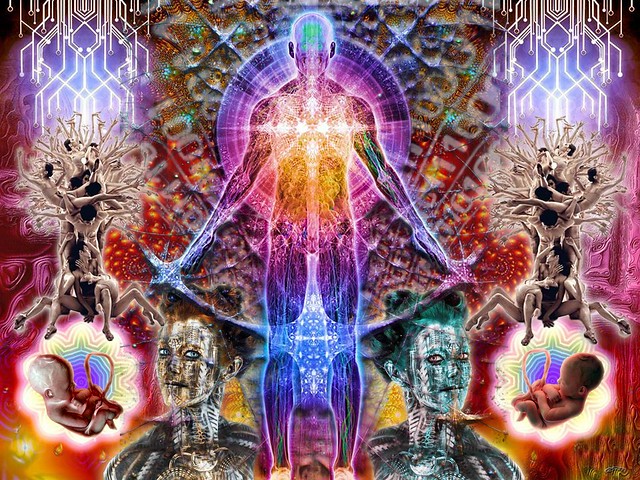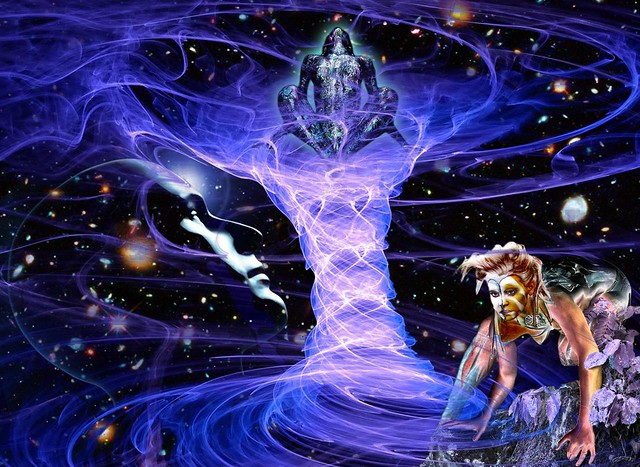Panspermia: Seeds Everywhere
Biological life impregnates
planets, where it gestates, until it returns to space symbiotic with its
technologies…
by Star
Larvae
The prospect of organic molecules from space having
contributed to the origin of life on Earth becomes less controversial with each new research project in astrochemistry. Scientists
keep finding more and more organic molecules in outer space, including DNA nucleobases and even vitamins. The abundance of organic molecules and
macromolecules in space and proposed mechanisms to produce the abundance should open
the skies to conjecturing about life itself originating in space.
But
such thinking is hard to find. No matter the extent to which scientists will
admit organic "building blocks" of extraterrestrial origin to the
terrestrial "broth" from which life is assumed to have arisen, the
broth remains unchallenged as the womb of the first Earthly cells. A nascent
geocentrism lurks in the minds of men. The new research on protostellar
chemistry challenges the need for a terrestrial broth to account for life on
Earth. The job of championing the heresy of extraterrestrial biogenesis fell to
the eminent British astronomer Sir Fred Hoyle.
During
the last decades of his life, Hoyle argued that biology cannot be native to
Earth, but must be of extraterrestrial origin. Hoyle did not originate the
hypothesis, called panspermia,
and he acknowledged its long history. But, with new research data in hand,
Hoyle waved the dust off the old idea and, in collaboration with astrochemist
Chandra Wickramasinghe, labored to bring it to public attention. Wickramasinghe
and colleagues continue the project today.
Hoyle's
campaign met with resistance from the scientific community generally, and to
the extent that he was not overtly attacked or dismissed, he was ignored. But
ongoing research continues to expand the catalog of organic molecules
identified in interstellar space and in comets, a catalog that now includes
everything from alcohols to amino acids (and HERE). And increasingly complex organics continue to be
found. In 2011, Researcher Sun Kwok of the University of Hong Kong analyzed
spectral data from the European Space Agency's Infrared Space Observatory and
NASA's Spitzer Space Telescope and found evidence of unsuspected organic complexity.
"We
know that these organics are being made in the circumstellar environment,"
Kwok said. According to an article on physorg.com, "The team's discovery suggests
that complex organic compounds can be synthesized in space even when no life
forms are present." "Our work has shown that stars have no problem
making complex organic compounds under near-vacuum conditions," says Kwok.
"Theoretically, this is impossible, but observationally we can see it
happening." Cosmic-scale organic chemistry
was not predicted by any scientific theory. It was an empirical surprise.
It
was an Empirical Surprise
This
part of the argument has been bolstered by the growing body of evidence for horizontal
gene transfer as a significant evolutionary mechanism. Researchers have
demonstrated that when viruses insert their genes into their host organisms—the
normal mode of infection—the viral genes can infect germ cells and appear in
the next generation of hosts. In this way, the genome of a species can be augmented with new genes. Scientists increasingly invoke
this process of gene transfer in their explanations of
evolutionary change. But in whatever ways scientists might concede that
genes get shuffled among organisms, few scientists look to outer space for
novel genetic material.
"Thus in the controversy
about the Plurality of worlds, it has been considered, on purely antecedent
grounds, as far as I see, to be so necessary that the Creator should have
filled with living beings the luminaries which we see in the sky, and the other
cosmical bodies which we imagine there, that it almost amounts to a blasphemy
to doubt it."
As
for the means by which interstellar bacteria and viruses might make their way
to planets, Hoyle identified comets as the likeliest vehicles. Comets originate
in, and during their eccentric orbits travel through, interstellar clouds of
organic dust and gas. Hoyle contended that organic material evaporates off of
comets as they round their host stars, a well-documented phenomenon in the case
of our own solar system, and that the freed material, including whole cells and
viruses—the controversial part—makes its way through planetary atmospheres to
the planets below.
In
short, Hoyle proposed that comets harbor microscopic life and disperse it
across the orbital paths of planets. Whether life "takes" or not on a
particular planet will be influenced by various contingencies idiosyncratic to
that planet. Such contingencies will include whether the planet is positioned
within a "habitable zone" surrounding its star. The idea is that only
planets at the proper distance from their stars will provide suitable
conditions for complex ecosystems to evolve. Habitable zones have been proposed
for entire galaxies, as well, being defined as the space at a given distance
from galactic center that includes stars of certain types, namely those that
form from "enriched" starter material, that which includes the
assortment of elements produced by previous stars and that constitutes the
necessary building material for making planets.
Hoyle's
primary collaborator, Chandra Wickramasinghe, continues to pursue evidence of
panspermia. A research team of which he was a member found evidence early in
2013 that a meteorite that broke up over Sri Lanka in December 2012 contained fossilized microbes. The
evidence has been disputed, but earned coverage in MIT Technology Review's blog. The growing
body of evidence for panspermia theory is archived and updated regularly by
advocate Brig Klyce at www.panspermia.org.
The
star larvae hypothesis extends the model of Hoyle/Wickramasinghe/Klyce by
positioning evolution—phylogeny—in
an overarching ontogeny and by doing so adding a teleological dimension to
their (and the normal) account of evolution.
H/W/K
incorporate mechanisms into normal evolution theory that extend the range of
genetic variability and which thereby give natural selection more to work with.
But this is all they do to extend the theory. The mechanisms they propose are
(1) horizontal gene transfer from viruses and bacteria to unicellular
eukaryotes and metazoans, a process itself given much to work with by (2)
continuing infall of viruses and bacteria from space. Horizontal transfer is
becoming less controversial as genetic sequencing data accumulate. Infall from
space, however, remains outside the boundaries of normal science. Regardless,
the H/W/K model retains science's bias against teleology.
Hoyle
conceived of planets as being like petri dishes in which bacteria multiply,
only to rejoin the life suspended in the interstellar medium when the planets
they inhabit meet their ultimate fates. This aspect of his thinking seems to be
Hoyle’s least satisfying conjecture. Panspermia is a one-way street in his
model, with no apparent role for complex, multicellular life other than to host
bacteria and viruses. As outside of mainstream thinking as Hoyle’s proposals
were, and to a significant degree still are, they nonetheless were highly
conventional in their nihilistic view of phylogenetic development. His is
another theory of evolutionary purposelessness.
The star larvae hypothesis, in
contrast, proposes that multicellular life plays an essential role in the
natural evolution of the cosmos. The hypothesis incorporates panspermia, which
it takes to be the critical process in the stellar life cycle that delivers
biological building blocks—bacterial life—and genetic sorters—viruses—to
planets. Beyond that it proposes that the natural cycle includes a "return
trip," the graduation of biological life to the adulthood of
extraterrestrial civilization and ultimately stardom.
That
graduation is a complex process that bridges the divide separating the organic
from the inorganic. It involves the metamorphosis of biological metabolism into
nuclear metabolism. The technological dimension of the process culminates in a
replenishing of the universe's essential building blocks, protons.
Tardigrades In Space
(3:17)
For more information about panspermia see http://nexusilluminati.blogspot.com/search/label/panspermia
- Scroll down through ‘Older Posts’ at the end of each section
Hope you like this
not for profit site -
It takes hours of work every day by
a genuinely incapacitated invalid to maintain, write, edit, research,
illustrate and publish this website from a tiny cabin in a remote forest
Like what we do? Please give anything
you can -
Contribute any amount and receive at
least one New Illuminati eBook!
(You can use a card
securely if you don’t use Paypal)
Please click below -
Spare Bitcoin
change?
Xtra Images by R. Ayana – https://farm8.staticflickr.com/7457/8732051100_b29033db60_h.jpg
For further enlightening
information enter a word or phrase into the random synchronistic search box @
the top left of http://nexusilluminati.blogspot.com
And see
New Illuminati – http://nexusilluminati.blogspot.com
New Illuminati on Facebook - https://www.facebook.com/the.new.illuminati
New Illuminati Youtube Channel - http://www.youtube.com/user/newilluminati
New Illuminati on Google+ @ https://plus.google.com/115562482213600937809/posts
New Illuminati on Twitter @ www.twitter.com/new_illuminati
New Illuminations –Art(icles) by
R. Ayana @ http://newilluminations.blogspot.com
The Her(m)etic Hermit - http://hermetic.blog.com
DISGRUNTLED SITE ADMINS PLEASE NOTE –
We provide a live link to your original material on your site (and
links via social networking services) - which raises your ranking on search
engines and helps spread your info further! This site is
published under Creative Commons Fair Use Copyright (unless an individual
article or other item is declared otherwise by the copyright holder). Reproduction
for non-profit use is permitted & encouraged, - if you give attribution to the work &
author and include all links in the original (along with this or a similar
notice).
Feel free to make non-commercial hard (printed) or software copies or
mirror sites - you never know how long something will stay glued to the web –
but remember attribution!
If you like what you see, please send a donation (no amount is too
small or too large) or leave a comment – and thanks for reading this far…
Live long and prosper! Together we can create the best of all possible
worlds…
From the New Illuminati – http://nexusilluminati.blogspot.com



